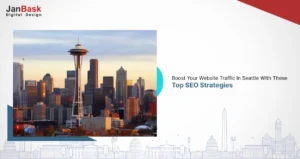
People are out there looking for exactly what you offer but your site’s nowhere in sight. And no, it’s not because your business isn’t good enough. It’s because search engines haven’t been told why you deserve to be on top.
Search engines, notably Google, form the foundation of digital visibility. With competition increasing across industries, ranking on the first page of search results can make or break your online success. It's no longer enough to be online; you must also be discoverable. Google's constantly evolving algorithms are now the gatekeepers between your company and potential customers. If you are not ranked high, you will not be seen.
SEO is far more complex than it once was. It's no longer necessary to stuff keywords into your content; instead, combine smart technical infrastructure, valuable content, a great user experience, and strong authority signals. Businesses that want to thrive must understand how these elements interact to influence search rankings. This guide will help you do just that: it will break down how to improve SEO rankings and show you tried-and-true strategies for improving your website’s SEO and increasing your digital presence.
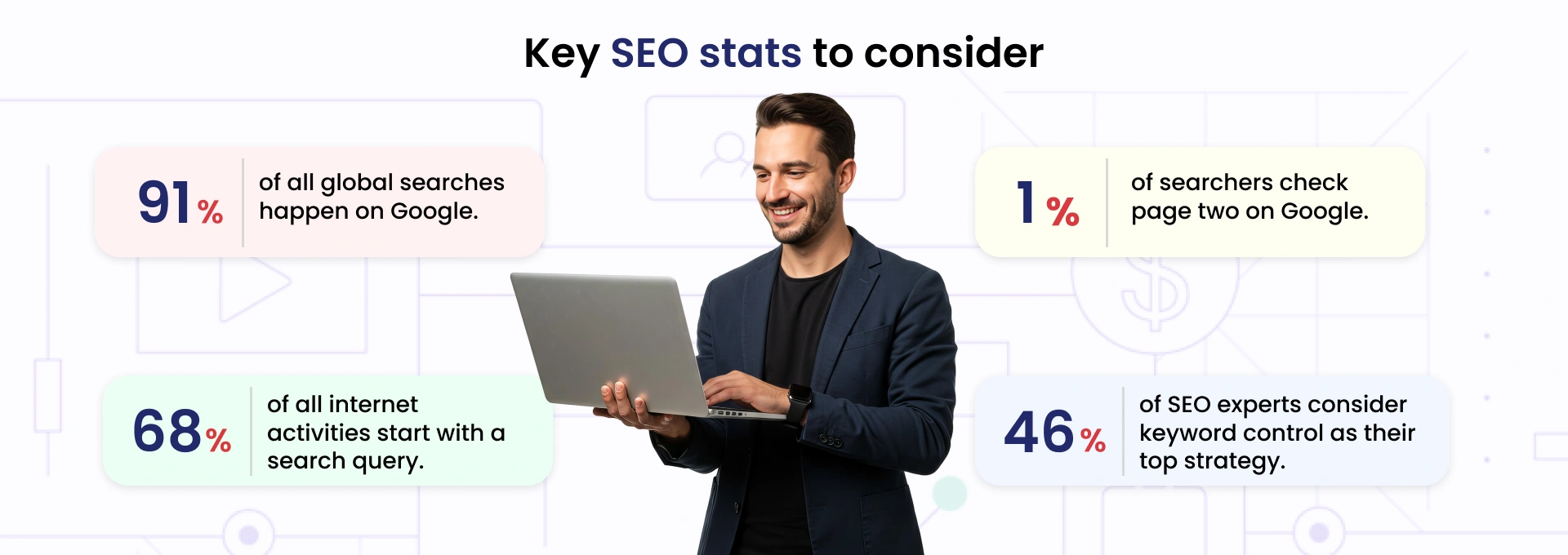
Establishing where your website currently ranks in the SEO field is essential before delving into execution plans. Let's first review your present SEO situation and set a development benchmark.
Your knowledge and ability to improve SEO rankings determine your digital success. Whether your company is content-based, service-based, e-commerce, or content-rich, your capacity to improve SEO rankings will define your capacity to engage your target market. The fight for digital visibility will be unparalleled, building an invisible wall whereby ranking lower means being invisible to your potential audience. Before optimizing, it’s vital to know where your website stands. Understanding your current SEO performance sets the foundation for effective improvements. The following steps will guide you through the process.
Before you make any SEO adjustments, it's important to know how your site is currently performing. Use this as your SEO baseline. Without it, you won't know what works, what doesn't, or how to track progress.
Consider this step as running a health check on your digital presence. By diagnosing your current state of SEO, you'll reveal technical vulnerabilities, content deficiencies, mobile restrictions, and ranking possibilities so you know precisely where to apply your energies next.
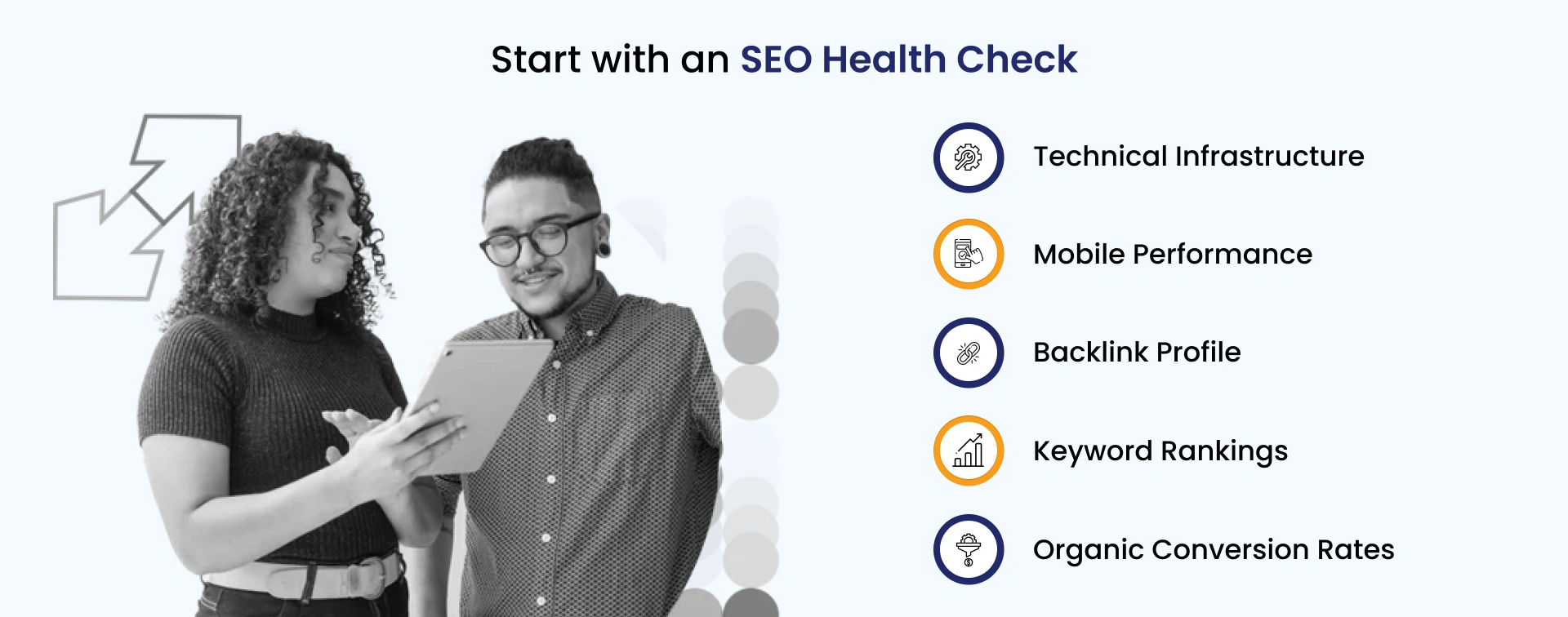
Modern SEO audits go considerably beyond basic keyword searches or backlink counting. The competitive scenario demands your audit to investigate various layers of your digital footprint. Start with your technological infrastructure: crawlability, mobile responsiveness, and website performance. Pay particular close attention to Core Web Vitals, which today affect the ranking of around 40% of websites. Carefully record every finding since they will guide your development direction to increase website SEO.
Pay great attention to factors directly affecting your user interaction and search visibility.
Your mobile performance metrics demand special attention because 63% of organic search users come from mobile devices. Track your mobile-specific ranks and user behavior on other devices.
When you've finished your audit and gathered your metrics, translate those learnings into productive goals. Instead of trying to "rank #1 for every keyword," begin with more realistic, staged objectives. For instance, you could advance a critical landing page from page two to page one or enhance search-driven conversions by 20% over the next three months.
Your objectives need to be aligned with business results. Focus on high-value pages—those concerning services, lead generation, or best content pieces. This ensures your SEO efforts pay off in terms of growth rather than vanity metrics.
Remember: the first three results receive more than Overall clicks. Although the ultimate goal may be to achieve that level, incremental gains can result in actual gains when monitored and measured over time.
Having the right tools makes your audit more efficient and your insights more actionable. At a minimum, Google Search Console should be used to identify indexing issues and keyword impressions. Pair it with Google Analytics 4 to evaluate bounce rates, engagement, and conversion paths.
For technical SEO and crawl diagnostics, tools like Screaming Frog, Ahrefs, or SEMrush are invaluable. They reveal site structure flaws, broken links, metadata issues, and backlink quality. To measure performance, especially speed and Core Web Vitals, rely on PageSpeed Insights or Lighthouse.

Technical SEO is the most underappreciated driver of search visibility. Most companies spend a lot of money on content and backlinks, but they don't pay attention to the underlying infrastructure that allows search engines to crawl, understand, and rank that content in the first place.

Your site's underlying technical structure directly affects how well search engines crawl and index your pages. Without it, even the most excellent content might go undiscovered or underperform in the rankings.
Your site structure should be such that it enables both users and search engines to locate content easily. A simple, rational structure translates into fewer clicks to find key pages and an improved flow of ranking power throughout your site.
Strive to make each of your site's pages accessible within three clicks of the homepage. Employ internal linking, breadcrumb menus, and categorized menus to establish an interconnected content network that assists crawlers and enhances user flow.

Imagine your XML sitemap as the search engine equivalent of a GPS. It instructs crawlers about the most important pages and how frequently they are updated. Whereas most companies only submit a general sitemap, sophisticated optimization takes it one step further.
Structure your sitemap by content type—blog posts, landing pages, products, etc.—and prioritize high-value URLs. Implement dynamic updates to automatically reflect changes and add metadata such as "last modified" dates and change frequency to assist search engines in crawling more effectively.
This additional structure can enhance crawl prioritization and provide timely indexing of new or updated content.
Robots.txt is usually underappreciated, but it's essential in determining what search engines can and cannot crawl. Get it wrong, and it can prevent critical pages from being crawled or can put the crawl budget on low-priority content.

Rather than provide blanket instructions, use precise directives that direct crawlers to your most valuable content. Block areas such as admin panels, duplicate URLs, or dynamic filters while making key landing pages and cornerstone content entirely crawlable.
Core Web Vitals aren't nice-to-haves ,they're at the heart of Google's algorithm. These performance indicators measure user experience by monitoring how quickly your site loads, how rapidly users can interact, and how stable the layout looks while loading.
To improve:
When these measures are better, people spend more time on your site and Google picks up on it. Websites with good Core Web Vitals perform better in desktop and mobile searches.
Security isn't merely a matter of safeguarding user information, it's now a ranking signal. All sites must employ HTTPS with a legitimate SSL certificate. Insecure pages lose visibility and deter users from remaining or converting.
Ensure all internal assets like images, scripts or files load securely. Resolve mixed content problems and employ contemporary SSL protocols. Implement security headers that prove compliance and secure users throughout their session.
Search engines prefer secure environments, and so will your visitors.
Site speed affects bounce rate, user experience, and general rank potential. Indeed, Google advises that pages load in less than 2.5 seconds for optimal performance results.
Use tools like PageSpeed Insights to detect heavy scripts, large media files, or poor code. Consider turning on caching, compressing CSS/JavaScript, employing modern image formats (such as WebP), and using a Content Delivery Network (CDN) to deliver assets more quickly across global locations.
A fast-loading website enhances SEO and significantly improves the experience for mobile users.
Search engines have become much smarter in the way they assess content. Ranking no longer depends on word count or repetition of keywords; it's about value, structure, and intent. Google now favors content that answers people's questions, shows expertise, and provides a seamless, enjoyable experience.
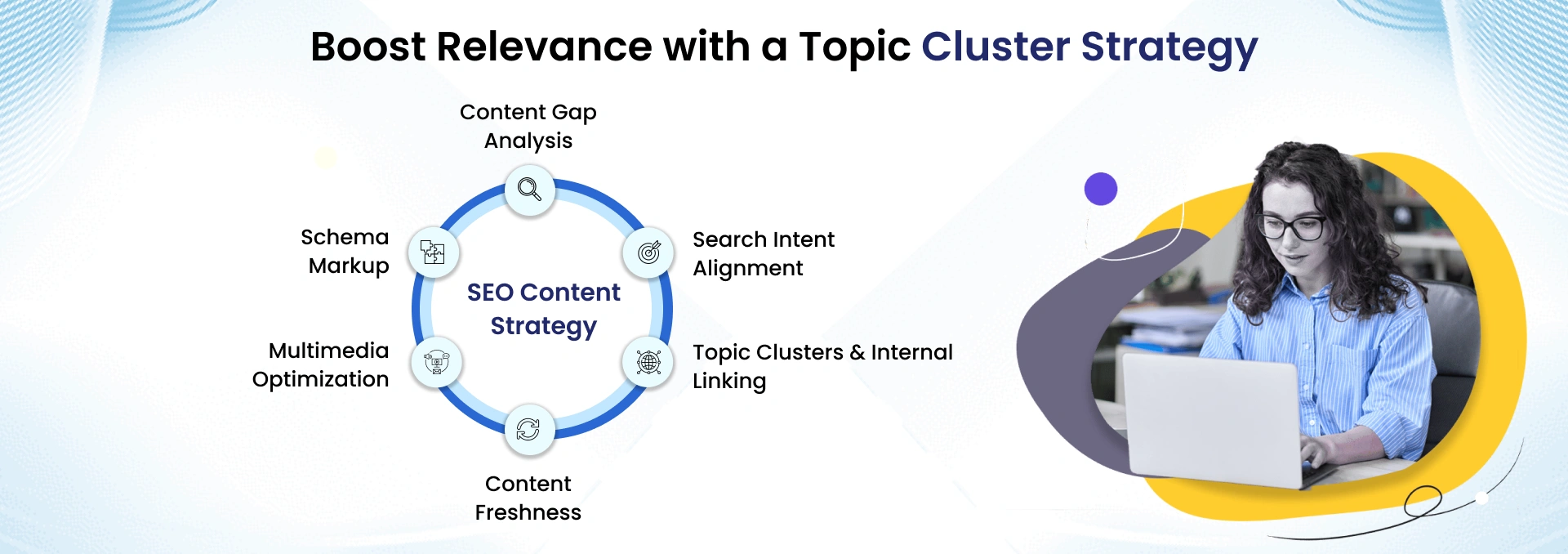
To enhance your rankings, you must develop content that serves human readers and search engines' algorithms. That implies an emphasis on clarity, context, structure, freshness, and authority within a well-planned content strategy.
Begin by reviewing your current content to identify where holes lie. Find keywords your competition ranks for that you don't. Determine missing pages, thin content, or stale content that doesn't meet the demands of modern search behavior.
You can use tools like SEMrush, Ahrefs, or Ubersuggest to analyze content gap reports and keyword overlap. These assist in revealing high-potential topics that are currently being searched but not yet covered (or optimized) on your website.
Completing these gaps with well-researched, high-value content enhances your topical authority and opportunity to attract new search traffic.
Google is fixated on matching search intent. Your page isn't going to rank if it doesn't fulfill the exact purpose behind the user's query—no matter how well-optimized it is.

That's why each content should be constructed around matching search intent. Know whether your audience is seeking information, a comparison, a solution, or a product—and then align your page's tone, format, and structure with that.
Topic clusters assist Google in perceiving the depth of your coverage. Rather than produce stand-alone blog posts, organize your content into pillars (primary topics) and clusters (supporting subtopics).
Your pillar page may, for example, be "Complete Guide to Technical SEO," with associated posts on Core Web Vitals, mobile responsiveness, XML sitemaps, etc. These should link to each other and helpfully be on the pillar page.
This format creates semantic significance to increase SEO, enhances internal linking potency, and communicates that your site is an authoritative source in your niche.
Google prefers content that is current and accurate. Even top-ranked pages can fall out of sight if they become stale. That's why content upkeep is essential.
Review your blog and service pages every 3–6 months. Update stale statistics, clarify confusing points, and introduce new sections where appropriate. Republishing updated content can significantly improve SEO ranking and result in huge jumps in click-throughs without beginning from scratch.
Make it part of your process to go back and see what's already live and treat content like a living asset, not a one-off project.
Multimedia not only improves user experience—it also contributes to search performance. Images, videos, infographics, and diagrams break up heavy blocks of copy, clarify complicated concepts, and enhance time on the page.
Google indexes multimedia, too, so ensure your images have descriptive filenames, good alt text, and are compressed for quick loading. Placing videos can engage more users and reduce bounce rates—both indirect ranking signals.
Steer clear of cliche stock images. Use custom illustrations, data graphics, and how-to walkthroughs to distinguish your content.
Schema markup (structured data) tells the search engines what your content is about. With proper implementation, it can unlock rich snippets of those rich search results that show ratings, FAQs, dates, or breadcrumbs inside the SERPs.

Apply schema to blog posts, how-to guides, FAQs, product lists, and articles. It will not affect rankings but significantly increase visibility, credibility, and click-through rates.
Even with the most excellent content and a technically well-constructed website, your SEO potential can fail without on-page optimization. This is where all tags, headings, images, and links on a page are optimized to communicate relevance, structure, and intent to users and search engines.
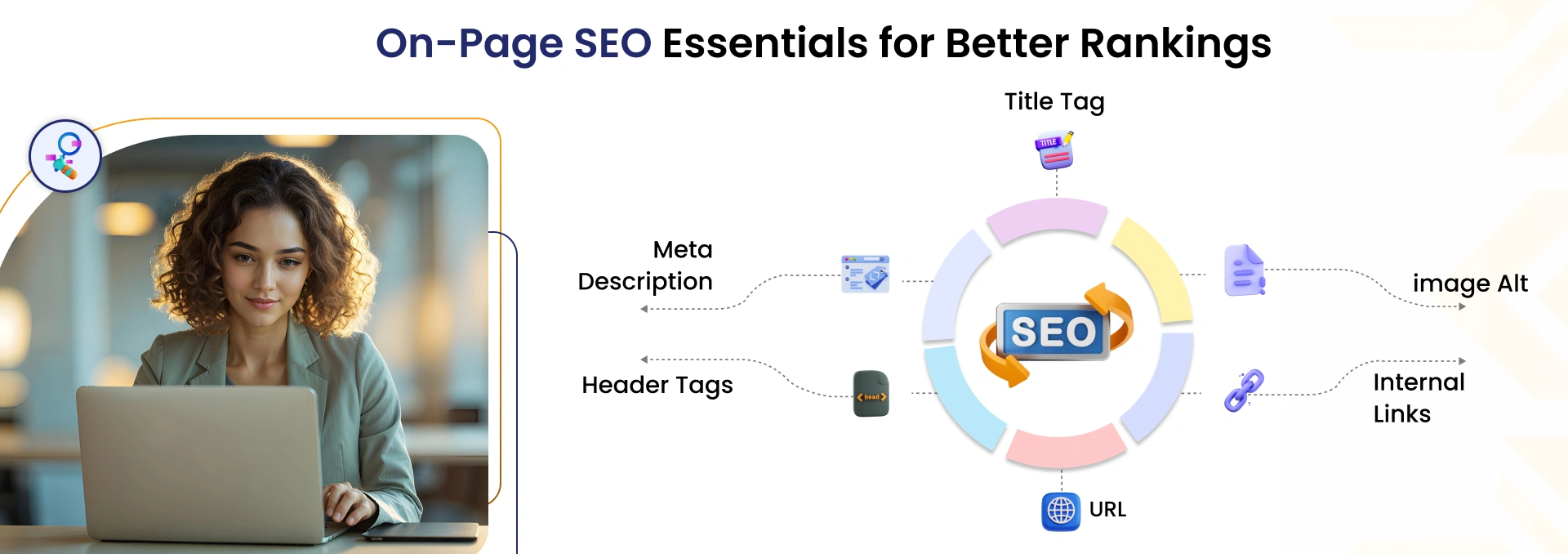
Google is using on-page factors to determine your page's subject, its structure, and how helpful it will be to a search visitor. Done effectively, On-Page SEO improves findability, boosts click-through rate, and optimizes the smoother user experience through search results to conversion.
Your title tag is the first thing users notice in search results—and one of the most powerful on-page ranking indicators. It needs to be concise, compelling, and include your target keyword, preferably at the start of the phrase.
A reasonable title tag directly addresses the user's desire while arousing curiosity or providing value. Refrain from keyword stuffing or generalization. Keep it as short as 60 characters to avoid being cut off in the SERPs.
For instance, the keyword "optimize Core Web Vitals" could be changed to:
“How to Optimize Core Web Vitals for Improved Rankings”
Although meta descriptions don't affect rankings, they strongly affect click-through rates (CTR)—which can indirectly enhance your SEO.
Use the meta description to define the page's value in roughly 155 characters. Add a call-to-action or emotional trigger, emphasizing what makes your content special. Every meta description should be written by hand—don't duplicate them across pages.
Treat it as your content's sales pitch: concise, compelling, and meant to earn clicks.
Header tags (H1, H2, H3, etc.) are not merely for presentation purposes—they assist both users and search engines understand your content organization.
Your H1 must be the primary page title and used only once. Subheadings (H2, H3, etc.) must divide your content into sensible sections, allowing it to be easily skimmed. Utilize keywords naturally in headers but make them readable and useful.
Headers also enable featured snippet possibilities since Google tends to draw from organized sections to present answers in the results themselves.
URL structure often gets ignored—but it can influence crawlability, clickability, and user trust.
Use short, meaningful URLs that describe the page’s topic. Avoid dynamic parameters, numbers, or vague words. Include your primary keyword, and use hyphens instead of underscores to separate words.

A clean URL can help users and search engines predict what to expect, improving relevance and usability.
Images add content but if not optimized, they slow down your site and damage performance scores. Compress image files without reducing quality, utilize next-gen formats such as WebP, and scale images correctly for mobile.
More significantly, include descriptive alt text. Screen readers are for accessibility, and Google will understand your graphics. Alt text also gets indexed, which helps improve SEO by building image search traffic.
Ensure that all pictures contribute. Such things as merely decorative graphics, without description or context, must be minimized or eliminated.
Images add content but if not optimized, they slow down your site and damage performance scores. Compress image files without reducing quality, utilize next-gen formats such as WebP, and scale images correctly for mobile.
More significantly, include descriptive alt text. Screen readers are for accessibility, and Google will understand your graphics. Alt text also gets indexed, which builds image search traffic.
Ensure that all pictures contribute. Such things as merely decorative graphics, without description or context, must be minimized or eliminated.
Google's algorithm now factors beyond content and links. It even looks at how users interact with your website and your UX affects your SEO.
Bounce rate, dwell time, click-through, mobile-friendliness, and levels of engagement signal to search engines if your content is relevant and worth a higher ranking. The better your experience, the bigger the signal—and the more competitive your ranks.
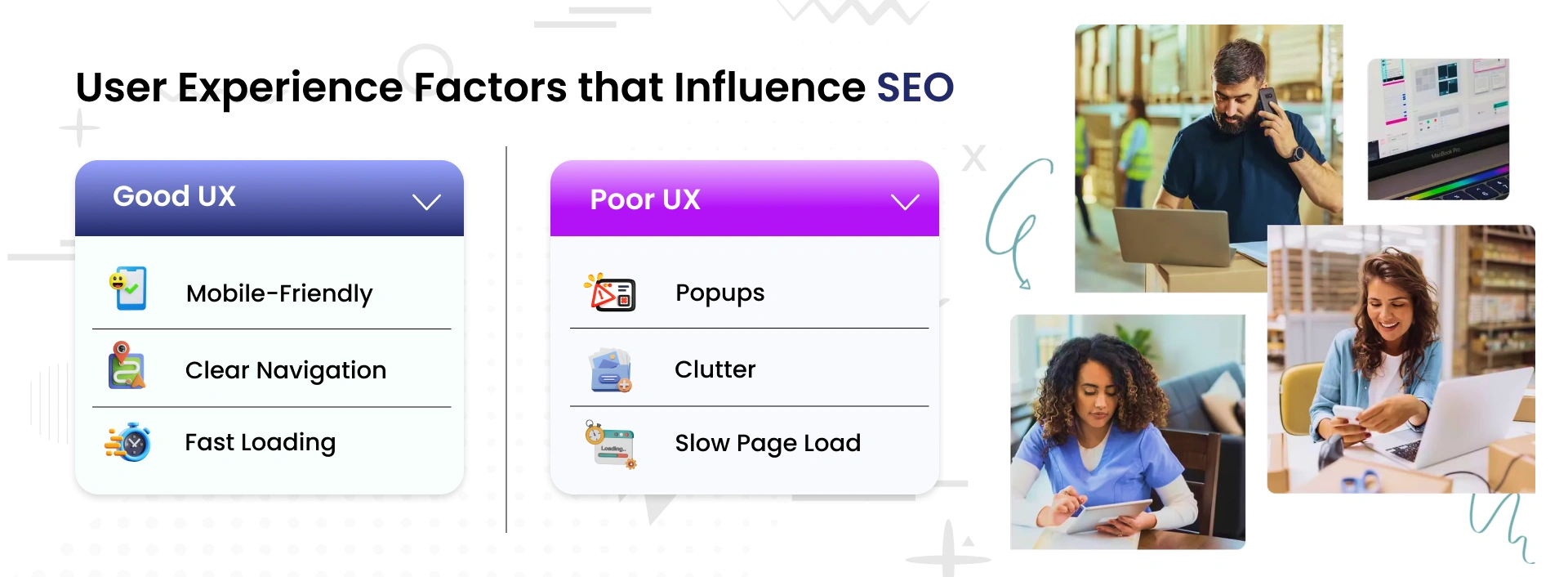
By making your site more usable, visually hierarchical, and accessible, you're not just optimizing for SEO you're establishing trust with users and having them stay longer.
Mobile-first indexing is the new norm for Google. That implies your mobile experience is the main version of your website as far as a search engine is concerned. If your mobile design is sluggish, difficult to navigate, or poorly formatted, your rankings will be hurt regardless of whether your desktop version is perfect
Ensure your design is responsive to every screen size, buttons are easily tappable, and font sizes are automatically changed for readability. Steer clear of horizontal scrolling or content clipping that annoys users and causes them to bounce quickly.
People hardly ever read from headline to foot of the page , they scan. That's why visual hierarchy is essential for helping folks absorb your content. Employ typography, color, whitespace, and segmentation to point out essential takeaways and channel readers organically from headline through CTA.
Begin with solid H1s and H2s, and use short paragraphs to break up content, along with pull quotes and subheadings. Illustrate each section using imagery or icons to give the eye something to land on. It's not only about aesthetics—it's about making content readable and frictionless.
A well-organized page lengthens dwell time, informing Google that your content is high quality and worth ranking.
Baffling site structure is among the quickest ways to lose a visitor. If visitors can't find what they need within a few clicks, they're more likely to bounce—and less likely to convert.
Keep your main navigation prominent and identical across all platforms. Instead of broad categories like "Services" or "Solutions," employ descriptive labels. Have short and dedicated dropdowns; never put your most relevant content (service or product pages) deeper than needed.
Furthermore, incorporate breadcrumb trails and internal linking to allow users to go smoothly from related content to another piece of relevant content.
Google measures how long people remain on your site. The longer they are there, the more valuable your content is in the algorithm's view. This is referred to as dwell time.
To enhance it, start with powerful headlines and hook sentences, maintain content in good order, and eliminate distractions such as autoplay videos or obnoxious popups. Provide a reason for visitors to scroll by adding visuals, internal links, and bite-sized summaries throughout the page.
While this occurs, it also lowers bounce rates by ensuring that content fulfills the intent of the searcher as quickly as possible. Sites that frustrate, confuse, or deny users typically lose them rapidly.
If your site has a lot of content or products, an internal search function can dramatically improve user experience. A well-functioning site search bar helps users find what they need faster, reducing frustration and encouraging deeper engagement.
In addition to usability, your site search results are an excellent source of SEO intelligence. It informs you what your visitors are searching for, providing ideas for fresh content, more effective navigation, or enhanced landing pages.
Monitor site search queries using Google Analytics 4 or your CMS interface to determine missed opportunities or vulnerabilities in your existing structure.
SEO isn't just about backlinks and keywords anymore but it's about credibility, too. Google stresses trust-based signals using E-E-A-T: Experience, Expertise, Authoritativeness, and Trustworthiness. These concepts inform everything from content visibility to eligibility for featured snippets.

In short, it won't rank well if your site does not feel reputable either to users or search algorithms. But by following a concise authority-building strategy, you can simultaneously increase your site's search trust and conversion ability.
Search engines prefer to see that real people with real-world expertise create your content. That's where E-E-A-T enters the scene. It's not one ranking signal but a set of signals Google uses to determine content credibility.

To comply with E-E-A-T requirements, show firsthand experience in your content. Use case studies, original observations, client outcomes, or data-driven suggestions. Back your content with properly cited sources, and refrain from thin or unsubstantiated claims that undermine trust.
Google favors content with identifiable authors particularly those specializing in the subject matter. Implement bylines, bios, and author pages that promote each author's credentials, industry experience, and published materials.
Implement author schema markup to enable Google to associate your authors with a wider content footprint. Add links to social profiles or third-party mentions to connect digital authority across platforms.
This is not merely about rankings , users are more likely to trust and convert to pages supported by authoritative authors, particularly in sophisticated or sensitive niches.
To establish trust, demonstrate that your advice or information is based on fact. Include proof points like:
Even faintly perceptible gestures like "as suggested by X platform" or "drawing from our experience with Y clients" add a layer of legitimacy that users and search engines pick up on.
When users know your dominance, they linger longer—and engagement begets richer ranking signals.
Google prefers sites that have good branding. Branded search traffic (individuals who type your name into Google) is a vote that your site is a brand and a known and trusted company. To create this, do brand-building endeavors beyond pure SEO.
Be visible on sites like LinkedIn, listed in reputable business directories, mentioned in relevant media, and ask happy customers to leave feedback. Over time, this creates recognition that Google detects as brand signals.
Good brands rank better even in highly competitive keyword arenas—not necessarily because of backlinks, but because of their trust reputation.
Trust is also generated through transparency and social proof. Ensure your site has:
If you've been mentioned in media, podcasts, or industry blogs—show those logos as "As Seen On" sections. Embed review widgets from Google, Clutch, or G2. Not only do these make users feel more confident, but they also build credibility in the eyes of Google's crawlers.
User trust is one of the most convincing types of authority. Show real customer reviews throughout your website not only on an explicit page. Incorporate them in your content plan, landing pages, and blog posts where applicable.
Customers' trust increases when they see that your solutions have helped other people. And when Google crawls legitimate reviews from trusted sources, it assumes your company to be more authoritative and trustworthy.
Use star ratings, full testimonials, and reviewer names or credentials wherever possible for maximum effect.
Backlinks are still one of Google's best ranking signals—but not all links are equal. It's no longer about quantity but quality, relevance, and authenticity. Obtaining backlinks from reputable, relevant domains informs Google that your site is authoritative and valuable to the web.
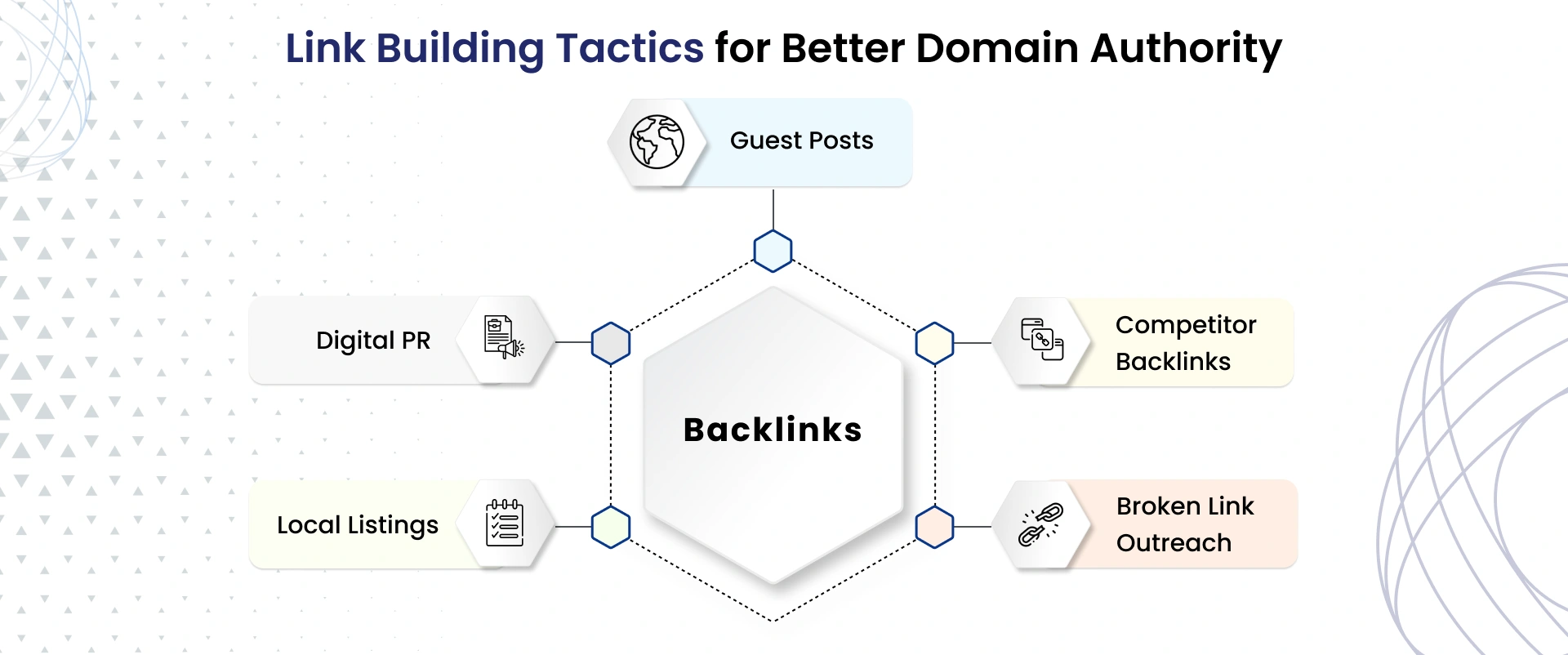
The secret to contemporary link building is establishing relationships, not merely pursuing URLs. The more other people mention your brand, link to it, and share it, the more authority you build—and that authority is reflected in your rankings.
Ditch old-school strategies such as bulk directory submissions or comment spam. Instead, aim to get links from relevant, high-authority sites in your niche.
You can achieve this through guest blogging, collaborations, being mentioned in roundup posts, or providing expert quotes to media publications. Better still produce valuable content (original research, tools, or guides) that others will want to link to naturally.
Google values earned, not manipulated, backlinks. A single good link from an authoritative source is worth more than a dozen bad ones.
Digital PR is perhaps the best method to create backlinks naturally. It entails writing opinion pieces, providing commentary to journalists, or supplying quotes for industry publications. Tools such as HARO or Qwoted link experts with journalists and bloggers searching for authoritative sources.
These earned mentions usually point back to your site and have SEO value, brand awareness, and referral traffic. The good news? These links usually reside on high-authority domains, providing long-term visibility benefits.
Approach digital PR as relationship-building. The more authoritative your commentary and the quicker your response time, the more often you'll be showcased.
If you don't know where to start, look first at where your top-performing competitors are obtaining their backlinks. Ahrefs, SEMrush, or Moz Link Explorer allow you to examine competitor link profiles in depth.
Find patterns: Are they mentioned on some blogs? Referenced in guides or reports? Quoted in magazines or business publications? This provides you with a map of publishers to pursue and the type of content that attracts links in your space.
The idea isn't to replicate them—but to know what's successful and create superior, more link-worthy content to contend.
One of the simplest link wins is getting backlinks that previously pointed to your site but now are a 404 error or a redirect to an incorrect page. These happen because URLs have been deleted, paths have broken, or a website has been migrated.
Use tools like Screaming Frog or Ahrefs to find lost or broken backlinks. Then, contact the referring site and give them an updated link. In most instances, they'll be willing to correct it—particularly if it enhances their UX.
Not only does this recover lost authority, but it also demonstrates that you're proactively servicing your digital ecosystem.
Local backlinks are valuable if you're targeting a particular region or city. These include local newspapers, business directories, chamber of commerce, and community site links.

Collaborate with local influencers, sponsor community events, or guest post to regional blogs. Local backlinks boost SEO and enhance your local pack and map listing visibility, which helps you rank for high-intent search terms such as "services near me."
Not all brand mentions are accompanied by a link, but they are still significant. Google can identify brand signals even in the absence of a link. These include social media chatter, reviews, forum discussions, and podcasts.
Create alerts using Google Alerts or Mention to monitor where your brand appears online. When you notice a mention with no backlink, email them asking if they would mind linking to your site.
These unlinked mentions are typically low-hanging fruit—particularly when the publisher already trusts and discusses your brand.
As the online arena becomes more competitive, merely keeping up with the SEO fundamentals will no longer be sufficient. You must be ahead with cutting-edge, innovation-fueled tactics to future-proof your rankings.
Google's algorithms are becoming more voice search behavior, AI-powered, user experience-based, and the latest web tech-based emphasizing JavaScript frameworks and Progressive Web Apps (PWAs). These trends aren't extras; they're defining the future of search.
Here's how to remain competitive in the changing SEO arena.

As more people use smart speakers and mobile voice assistants, more individuals search online using natural, conversational language. These searches are longer, more definitive, and expressed in question form.
Optimize your content using long-tail keywords and natural phrasing to take advantage of voice search. Incorporate question-based subheadings such as "What is a sitemap?" or "How do I speed up my site?" and include clear, concise answers immediately below.
Include resources such as Answer the Public or Google's People Also Ask to discover actual voice-style questions. Voice-friendly pages do well in featured snippets, providing you with double exposure.
International market growth takes more than translating content. An effective international SEO approach needs to take into account hreflang implementation, cultural sensitivities, and regional search patterns that affect rankings in various markets.
One significant benefit is in developing market-specific content that resonates with the local audience without compromising brand consistency. This includes localized keyword research, tailoring content to include regional references and examples, and aligning with local search intent.
Furthermore, creation of regional backlinks and the utilization of local server infrastructure may increase authority and performance. Contemporary global SEO practice also customizes the user experience to local device usage, connection speeds, and interaction patterns so that relevance and usability are provided everywhere.
If your site is constructed using popular JavaScript frameworks such as React, Angular, or Vue, you must ensure that Google can crawl and render your pages correctly. Although Google can now execute JavaScript, it's not always instantaneous or reliable.
Employ server-side rendering (SSR) or dynamic rendering to offer a pre-rendered HTML version to crawlers. Test your pages with Google Search Console's URL Inspection Tool and Lighthouse to detect indexing problems.
Also, ensure all critical SEO aspects (title tags, meta descriptions, schema) are incorporated during server-side rendering.
PWAs marry the capabilities of an app with the discoverability of a website. They provide offline capability, push messages, and quicker load speeds—capabilities that enhance engagement, conversion, and dwell time.
Google prefers speedy, secure, and mobile-responsive experiences, and PWAs are an intelligent choice for SEO. Ensure your PWA complies with SEO best practices by correctly delivering static URLs, applying metadata, and leveraging HTTPS and service workers.
If you’re in ecommerce, travel, or content publishing, PWAs can significantly reduce bounce rates and increase repeat visits.
Retaining a competitive edge in search visibility nowadays primarily rests on using artificial intelligence and machine learning. Modern SEO managers depend on automatic content optimization systems that continually improve material depending on performance statistics and new trends.
Predictive search intent research helps companies forecast and control changing search activity before rivals, generating first-mover benefits in newly developed topic areas. Customized content experiences based on user activity patterns offered by dynamic user experience customization significantly affect engagement measurements, impacting rankings. By identifying and resolving problems before they affect performance, automated technical SEO monitoring preserves ideal visibility free from constant human effort.
Advanced content gap finding and resolution methods using artificial intelligence identify lost opportunities and content flaws relative to competing resources, guaranteeing full topic coverage.
Featured snippets—those answer boxes at the top of results pages—can drive huge traffic to you. Your content should give direct, organized answers to search queries to be ranked there.
Present your content as lists, tables, or brief paragraphs. Limit definitions to less than 50 words and put them immediately after a related subheading. Employ schema markup (FAQ or How To) to raise your probability of being drawn into the snippet box.
Pages in snippets tend to have higher authority and CTR—despite not ranking #1 organic."
SEO is not something you can "set and forget." It's a dynamic, constantly evolving process that demands regular monitoring, testing, and tweaking. Without a good tracking and measurement strategy, even well-optimized sites can fall back in rankings or miss out on growth opportunities.

To achieve long-term SEO success, you require systems that report performance and anticipate problems, raise flags on opportunities, and adapt to Google's updates. That is how you translate strategy into lasting results.
Good search engine optimization is more than essential ranking monitoring. Using intelligent analysis, establish a comprehensive KPI system appropriate for your business objectives. Pay great attention to elements immediately influencing your financial line: user behavior, conversion rates, income attribution, and natural traffic quality. Use advanced segmentation to understand performance across numerous content categories, user intentions, and conversion funnels.
You can't optimize what you can't measure. Google Analytics 4 provides event-based tracking beyond page views so that you can track interactions such as scroll depth, video playback, and button clicks.
Utilize Google Tag Manager to track eBook downloads, link clicks, or form submissions to connect organic traffic to actual results.
Also, break down organic traffic by location, device type, and landing page to see which platforms and content are performing—and which require your attention.
A complete SEO audit isn't just for newly built sites or stand-alone plans it must be an ongoing, periodic task. As your site grows, technical mistakes, performance issues, broken links, and stale content can creep up on you.
Use tools such as Screaming Frog, Ahrefs Site Audit, or Semrush Site Health Score to audit for crawlability, status codes, duplicate content, mobile usability, and Core Web Vitals. Conduct these audits at least quarterly and monthly if you publish regular updates.These audits help increase SEO visibility by validating what’s working and what needs rethinking.
When your audits are proactive rather than reactive, you beat traffic dips and ranking falls.
The lead algorithm moves through careful reaction and exhaustive analysis. Track industry debates, formal announcements, and early warning signals for your site's performance criteria. Record carefully past successful modifying methods and algorithm impacts. Create fast response systems to regulate unanticipated ranking swings and stop hasty decisions in reaction to temporary changes.
SEO isn't about visibility but it's about value. To get stakeholder buy-in or tweak your strategy smartly, quantify SEO's impact on your bottom line.
Utilize goal tracking in GA4 to track leads, buys, or other conversions from organic searches. Add that to attribution models to see how SEO contributes to multi-touch funnels particularly for B2B or high-ticket enterprises.
When you can tie content to revenue, you transform SEO from a cost center into a business growth engine.
This book ranks highly in search calls for three key components: technical accuracy, strategic content, and first-rate user experience. It provides battle-tested techniques to cut through the digital noise and guarantee long-term search exposure in your market space. By following these strategies, you'll know exactly how to improve SEO on your website in any competitive landscape.

Innovative companies understand that applying good SEO is not a one-person trip. JanBask Digital Design turns complex search problems into quantifiable benefits. Our track record of accomplishment is demonstrated in the success stories of companies that now control the search results in their industry.
Find out where your site ranks. Avoid guessing and receive an expert view of your search performance. Our SEO experts will evaluate your website's potential and present what it takes to outrank your rivals. Get in touch right now for your bespoke site study and learn how to boost SEO for your specific website needs.
M
Appreciated the step-by-step layout. Really helped me focus my SEO efforts.
D
This blog simplified SEO for me! I finally understand what to focus on to boost rankings.
C
Broke down SEO in a way that actually makes sense. I loved the keyword strategy section—it helped me optimize my content and improve visibility.
M
Perfect for small business owners like me. I didn’t know where to start, but this guide gave me actionable steps that work.
A
Great blog for SEO beginners!
J
Easy SEO wins, highly recommended.